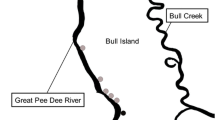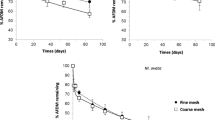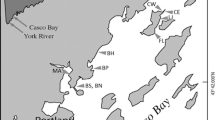Abstract
We examined characteristics of the invertebrates consumed by mallards (Anas platyrhynchos) and green-winged teals (Anas crecca) and responses of these invertebrates to manipulations of flooding date in Suisun Marsh, Solano County, CA. Numbers ofChironomus stigmaterus midge larvae (Chironomidae) andEogammarus confervicolus amphipods (Gammaridae) in mallard esophageal samples were positively correlated with abundance of these invertebrates in wetlands. Mallards primarily consumed large midge larvae (fourth instars) and amphipods (>5 mm in length). Smaller green-winged teals consumed smaller midges. Mallards consumed fewTrichocorixa verticalis water boatmen (Corixidae) orCricotopus sylvestris midge larvae, despite their being abundant. Wetlands first flooded in early September had higher winter populations of amphipods andBerosus ingeminatus beetle larvae (Hydrophilidae) than wetlands first flooded in late October. Late-winter abundance of benthicC. stigmaterus midge larvae was highest at 40-cm water depths in the former habitats and at 20-cm depths in the latter habitats.
Similar content being viewed by others
Literature Cited
Batzer, D. P. and V. H. Resh. 1992. Macroinvertebrates of a California seasonal wetland and responses to experimental habitat manipulation. Wetlands 12:1–7.
Connelly D. P. and D. L. Chesemore. 1980. Food habits of pintails,Anas acuta, wintering on seasonally flooded wetlands in the northern San Joaquin Valley, California. California Fish and Game 66: 233–237.
Euliss N. H., Jr., R. L. Jarvis, and D. S. Gilmer. 1991. Feeding ecology of waterfowl wintering on evaporation ponds in California. Condor 93:582–590.
Euliss, N. H., Jr., and G. Grodhaus. 1987. Management of midges and other invertebrates for waterfowl wintering in California. California Fish and Game 73:238–243.
Euliss, N. H., Jr. and S. W. Harris. 1987. Feeding ecology of northern pintails and green-winged teal wintering in California. Journal of Wildlife Management 51:724–732.
Garcia, R., K. S. Hagen, and W. G. Voigt 1990. Life history, termination of summer diapause, and other seasonal adaptations ofAgabus disintegratus (Crotch) (Coleoptera: Dytiscidae) in the Central Valley of California. Quaestiones Entomologicae 26:139–149.
Heitmeyer, M. E., D. P. Connelly and R. L. Pederson. 1989. the Central, Imperial, and Coachella Valleys of California. p. 475–505.In L. M. Smith, R. L. Pederson, and R. M. Kaminski (eds.) Habitat Management for Migrating and Wintering Waterfowl in North America. Texas Tech University Press, Lubbock, TX, USA.
Heitmeyer, M. E. and L. H. Fredrickson. 1981. Do wetland conditions in the Mississippi Delta hardwoods influence mallard recruitment? Transactions of the North American Wildlife Natural Resources Conference 46:44–57.
Johnson, D. H. 1980. The comparison of usage and availability measurements for evaluating resource preference. Ecology 61:65–71.
Kirk, R. E. 1982. Experimental design. Second edition. Brooks/Cole, Belmont, CA, USA.
Krapu, G. L. 1981. The role of nutrient reserves in mallard reproduction. Auk 98:29–38.
Mall, R. E. 1969. Soil-water-salt relationships of waterfowl food plants in the Suisun Marsh of California. California Department of Fish and Game, Wildlife Bulletin 1, Sacramento, CA, USA.
McLachlan, A. J. 1970. Some effects of annual fluctuations in water level on the chironomid communities of Lake Kariba. Journal of Animal Ecology 45:105–13.
Merritt, R. W. and K. W. Cummins (eds.) 1984 An Introduction to the Aquatic Insects of North America. Second edition. Kendall/Hunt Publishing Co., Dubuque, IA, USA.
Miller, M. R. 1987. Fall and winter foods of northern pintails in the Sacramento Valley. California. Journal of Wildlife Management 51:405–414.
Murkin, H. R. and B. D. J. Batt. 1987. The interactions of vertebrates and invertebrates in peatlands and marshes. Memoires of the Entomological Society of Canada 140:15–30.
Murkin, H. R. and J. A. Kadlec. 1986. Relationships between waterfowl and macroinvertebrate densities in a northern prairie marsh. Journal of Wildlife Management 50:212–217.
Nudds, T. D. and J. M. Bowlby. 1984. Predator-prey size relationships in North American dabbling ducks. Canadian Journal of Zoology 62:2002–2008.
Pennak, R. W. 1989. Fresh-water Invertebrates of the United States. 3rd edition. John Wiley and Sons, Inc. New York, NY, USA.
Polhemus, J. T. 1984. Aquatic and semiaquatic Hemiptera. p. 231–260.In R. W. Merritt and K. W. Cummins (eds) Aquatic Insects of North America. 2nd edition. Kendall/Hunt. Dubuque, IA, USA.
Rollins, G. L. 1981. A guide to waterfowl habitat management in Suisun Marsh. California Department of Fish and Game Publication. Sacramento, CA, USA.
Swanson, G. A. 1978. A water column sampler for invertebrates in shallow wetlands. Journal of Wildlife Management 42:670–671.
Swanson, G. A. and J. C. Bartonek. 1970. Bias associated with food analysis in gizzards of blue-winged teal. Journal of Wildlife Management 34:739–746.
Swanson, G. A. and M. I. Meyer. 1973. The role of invertebrates in the feeding ecology of Anatinae during the breeding season. p. 143–185.In Waterfowl habitat management symposium, Moneton, New Brunswick, Canada.
Swanson, G. A., G. L. Krapu, J. C. Bartonek, J. R. Serie, and D. H. Johnson. 1974b. Advantages in mathematically weighting waterfowl food habits data. Journal of Wildlife Management 38:302–307.
Swanson, G. A., M. I. Meyer, and J. R. Serie. 1974a. Feeding ecology of breeding blue-winged teals. Journal of Wildlife Management 38:396–407.
Swanson, G. A., G. L. Krapu, and J. R. Series. 1979. Food of laying female dabbling ducks on the breeding grounds. p. 47–55In T. A. Bookhout (ed). Waterfowl and wetlands-an integrated review. Proceedings of the 1977 symposium. Madison, WI. Wildlife Society, Washington, DC, USA.
Walker, E. D. and W. J. Crans. 1986. A simple method for samplingCoquillettidia perturbans larvae. Journal of the American Mosquito Control Association 2:239–240.
Author information
Authors and Affiliations
Additional information
Reprint requests should be sent to V.H. Resh.
Rights and permissions
About this article
Cite this article
Batzer, D.P., McGee, M., Resh, V.H. et al. Characteristics of invertebrates consumed by mallards and prey response to wetland flooding schedules. Wetlands 13, 41–49 (1993). https://doi.org/10.1007/BF03160864
Received:
Revised:
Accepted:
Issue Date:
DOI: https://doi.org/10.1007/BF03160864




